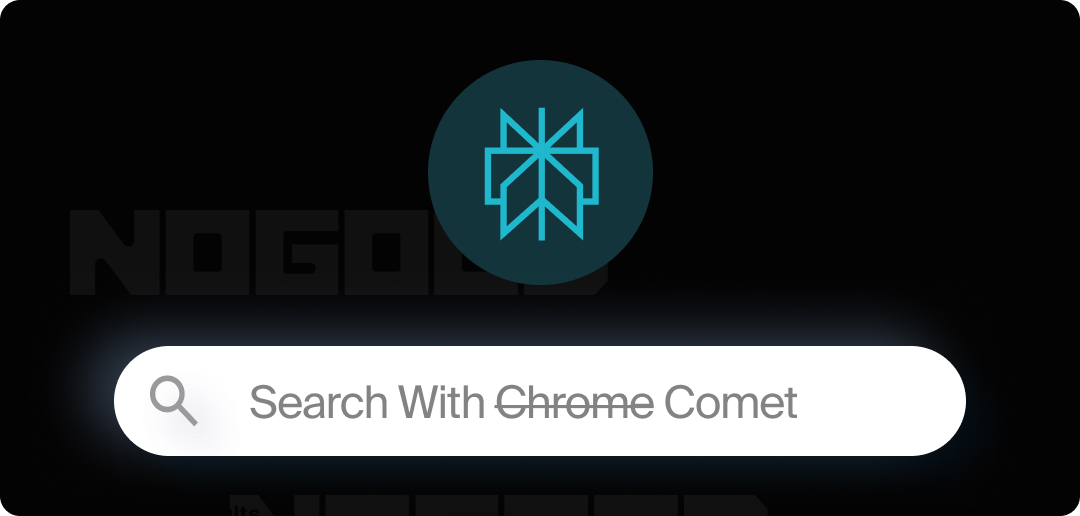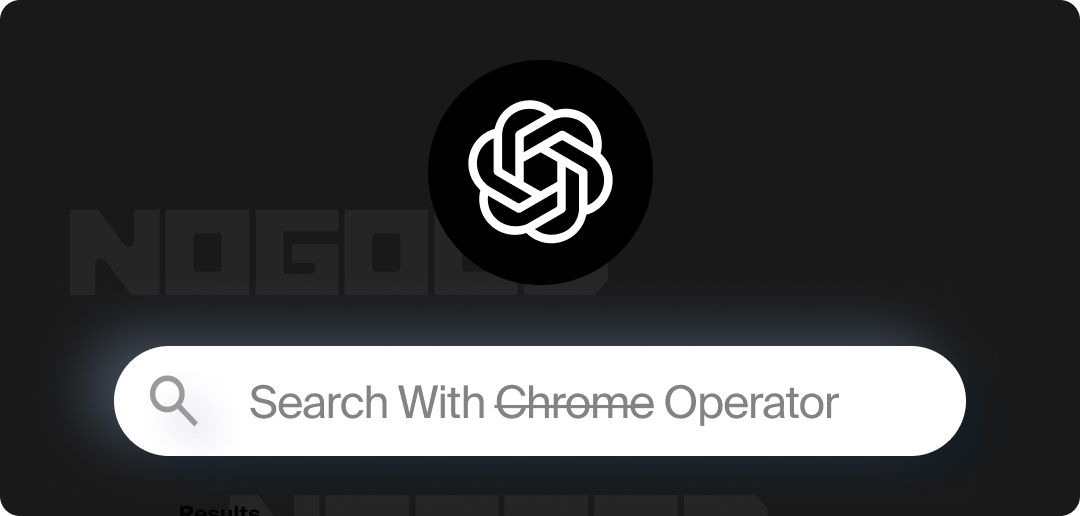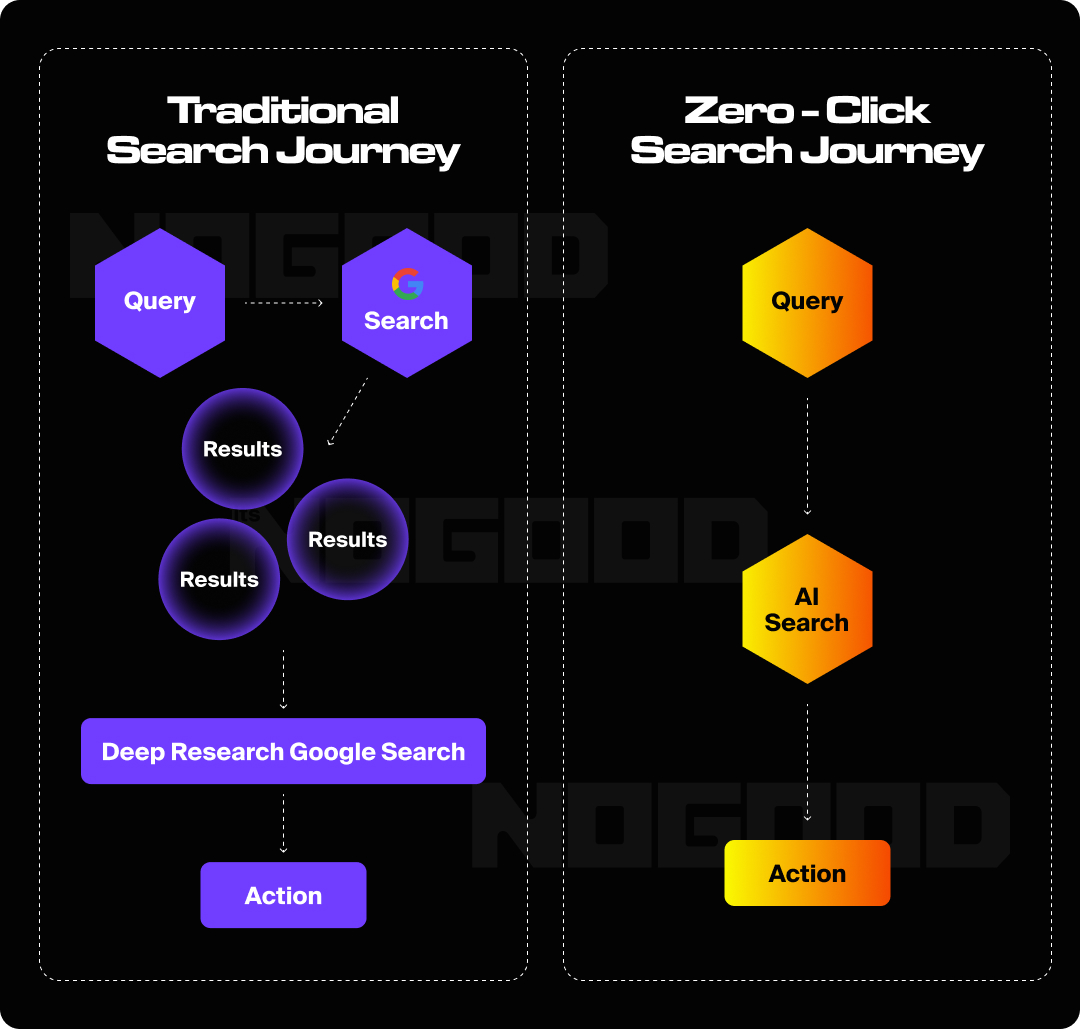Within the past couple of months, both ChatGPT and Perplexity have announced their intention of introducing search engines, furthering the impact of organic AI search and ushering in the era of AI paid search. We all saw this coming—but what does it mean?
How do we prepare to take advantage of this opportunity? How are forward-thinking, future-focused growth marketing teams going to leverage this for their clients? How will it differ from (or work together with) Google Ads? And finally, what does it mean for how users search in traditional and AI engines?
Let’s start with what we do know:
Perplexity AI: The Launch of the “Comet” Browser

Perplexity’s search engine, Comet, was rolled out to Perplexity Max subscribers on July 9, 2025. Over the remainder of the summer, they’ll be slowly rolling it out to other users who are currently on an invite-only waitlist. Here’s some information about Comet:
- “Browse at the speed of thought”: Perplexity describes Comet as a shift “from browsing to thinking,” aiming to provide instant, AI-generated summaries and answers directly within the browser, reducing the need to navigate through multiple links—if you’re familiar with Google’s AI Mode, this might sound familiar.
- Comet Assistant: A key feature of Comet is the “Comet Assistant,” an AI agent that operates in the sidebar. It can summarize webpages, answer questions about content, and even automate tasks like booking meetings or sending emails based on what you’re viewing.
- Chromium-Based: Comet is built on the open-source Chromium project, meaning it supports existing Chrome extensions and allows for the seamless import of bookmarks and settings, lowering the barrier to entry for some users.
- Challenging Google: Perplexity is explicitly positioning Comet as a challenge to Google’s dominance in both search and Browse, aiming to “kill the click” and provide a more direct, AI-driven experience powered by Perplexity’s AI search engine.
OpenAI (ChatGPT): The Launch of the “Operator” Browser

In “space race”-esque fashion, OpenAI is also releasing a search engine—they’ve called it Operator. While there is no set release date for Operator, many sources are suggesting a launch within days or weeks.
- AI-Centric Experience: The core differentiator of Operator will be deep integration with OpenAI’s AI capabilities. Instead of a traditional browser interface with tabs and search bars, it’s expected to feature a conversational, ChatGPT-like UX.
- “Operator” AI Agent: Another key component is likely an AI agent also called “Operator,” designed to perform complex tasks on behalf of the user. This could include summarizing web pages or entire topics, answering questions directly by pulling information from across the web, proactively suggesting relevant content, automating tasks like booking reservations and filling out forms, and even completing purchases directly within the browser.
- Monetization Strategy: While not stated, the broader strategy suggests a shift towards monetizing free users, potentially through integrated advertising models within the AI-driven browsing experience.
- Strategic Hires: OpenAI has reportedly hired former Google VPs who were part of the original Chrome development team, underscoring their serious intent.
- Data Control: One of the motivations for building a standalone browser is reportedly to gain more control over user data collection.
- Built on Chromium: Like Perplexity, OpenAI’s browser is reportedly also being built on the open-source Chromium project. This allows for compatibility with existing web standards and potentially Chrome extensions.
- Direct Challenge to Google Chrome: Similar to Perplexity, OpenAI’s move into the browser space can be interpreted as a direct competitor to Google Chrome and Google Ads. By controlling the browser, OpenAI would gain direct access to user data and browse behavior.
Essentially, what we’re seeing can be summed up as this: a bigger play for marketing dollars. If Perplexity and ChatGPT’s browser were to launch tomorrow, we can expect ad platforms to follow suit rather quickly. How do we set ourselves up for success?
How This Impacts Paid Search Advertising & Media Purchasing
Shift From Keywords to Intent & Conversation
- (Even) Less Reliance on Traditional SEO: While AI search isn’t particularly news, search strategies will continue to center even more around structured data, high-quality content, visibility, and brand awareness. Traditional SEO focused much more heavily on keyword targeting and link building. Brands who carve out authoritative niches will see the greatest amount of success within AI search engines.
- Emphasis on Conversational SEO: Marketers and copywriters will need to optimize content to answer questions naturally and comprehensively. This involves:
- Anticipating and answering follow-up questions that may stem from the main prompt.
- Answering queries in a conversational tone, with the most important part of the answer written in plain, simple, natural language (if I may—”if it’s generated by AI, it won’t fly”).
- Answering the main query and follow-up queries concisely, making the content easy for AI models to synthesize.
- Understanding User Intent: AI excels at understanding the deeper intent behind a query. Marketers will need to focus on mapping content (and ads) to solve for complex user needs and scenarios, not just isolated keywords. Step into the audience’s shoes; think about what they actually want to know.
New Ad Formats & Targeting
- Native & Contextual Ads: Expect ads that are seamlessly integrated into AI-generated answers, summaries, or conversational flows. These will be highly contextual, appearing when the AI determines they are most relevant to the user’s current query or task.
- Agentic Advertising: With AI browsers like Comet and Operator acting as “assistants”, ads could become more proactive and even “agentic”. For example, if a user asks for a flight recommendation, the AI might provide not only links, but go as far as to surface a pre-filled booking form from a sponsored airline.
- Personalization: AI’s ability to understand user context, history, and preferences will lead to hyper-personalized ad experiences, potentially making ads feel less intrusive and more helpful.
Data & Attribution Challenges (& Opportunities)

- Less direct website traffic: If AI provides direct answers, users may not click through to websites as often—or at all. In fact, 58.5% of searches in the US now end in zero clicks. This means marketers need to adapt their metrics beyond website traffic and focus on impressions, engagement with AI-generated content, and direct conversions within the AI environment.
- New Attribution Models: With zero-click searches and personalized advertising, tracking attribution and conversions will also become more complex. Marketers will need to understand how AI interactions influence the customer journey, even if there isn’t a direct click from an AI answer to a brand’s website.
- Wondering about other ways to attribute AI discovery for your brand? Implement a checkout survey that asks where the customer heard about you.
- First-Party Data Importance: First-party data will be even more critical for feeding AI models to understand audience segments and personalize experiences.
Creative & Content Evolution
- Concise & Impactful Content: AI’s main mode of operation is to summarize. Marketers will need to create content that can be easily digested and summarized by AI while still retaining its core message and brand voice.
- Multimodal Content: As AI handles images, video, and voice search more proficiently, marketers will need to think about optimizing content across these different modalities for AI understanding and display.
- Ethical AI in Advertising: With AI-generated content and ad placements, transparency and ethical considerations (e.g., avoiding bias, clear disclosure of sponsored content) will be paramount.
We’ve known some of these things for a while now and—as expert growth marketers—certainly implemented a few. But given the dramatic shift from only organic content (falling within AEO and SEO spaces) to both organic and paid, marketing teams will need to think even deeper about how marketing dollars are best spent to drive results.
How Marketing Teams Should Prepare for AI Paid Search Now
Marketer to marketer, we will all have to work together to understand and adapt to the new world of AI monetization—here’s the core concepts we’ve identified and how NoGood’s growth marketing experts are preparing:
From Finding to Being Found
Google Ads involves bidding on keywords to show up at the top of the SERP when someone searches a keyword within your campaign. Traditional search involves targeting a few keywords within a common keyword topic to push your content to the top of the SERP.
In AI browsers, the AI answers or acts on behalf of the user. Your goal is for your content to be included in the answer the AI provides, or the action it takes.
Action Items & Strategy
- Identify Core Questions: List the top 20-50 questions your target audience asks about your offering and industry. Use keyword research tools, customer support logs, feedback from sales, and “People Also Ask” sections on Google and Perplexity.
- Content Gap Analysis (With an AI Focus): For each question, assess if your current content directly and concisely answers it. If not, mark it for creation or revision.
- Reverse Engineer AI Answers: Go to ChatGPT and Perplexity. Ask questions related to your offerings. Analyze the answers:
- Do they cite your website?
- Is the information accurate?
- What sources do they typically pull from?
- How concisely do they summarize?
- What follow-up questions do they suggest?
- Prioritize Content Creation & Revision: Focus on creating new content or updating existing content to be the definitive, concise answer for these high-priority questions.
- Identify Key User Journeys & Tasks: Map out the most common tasks users want to accomplish related to your business (are they booking demos, purchasing, or looking for support?).
- Audit Current CTA Clarity: Review your website’s calls to action. Are they clear, explicit, and easy for an AI (and human) to understand?
- Optimize for Machine Readability
- Forms: Ensure forms are standard HTML and easy to parse programmatically.
- Product Data: Use consistent, clear product attributes.
- Booking Systems: Verify your booking system has well-documented APIs or clear, structured HTML that an AI agent could interact with.
- API Exploration (Long-Term): Research whether your current platforms (CRM, eCommerce, scheduling) offer APIs. While direct ad platform API integration might be future-state, understanding your capabilities now will be an advantage.
- Test With AI: Use ChatGPT (and soon, Operator) to role-play a user. Can the AI easily find information to complete a task on your site? Can it identify your CTAs?
From Clicks to Contextual Relevance & Resolution
Traditionally, Google Ads campaign success is measured by maximizing clicks to your website while minimizing spend. Traditional search success is measured by quantifying SERP impressions and connecting them to organic conversions.
Success in AI browsing is about being the most relevant and helpful solution, leading to a direct conversion within the AI environment or an on-site conversion from a high-intent, pre-qualified lead.
Action Items & Strategy
- Baseline Current Performance: Understand your existing metrics for brand mentions, direct conversions, and assisted conversions.
- Introduce AI Visibility Metrics, such as:
- Brand Mentions in AI Answers: Set up tools (e.g., Goodie, Mention, Brandwatch, or custom AI monitoring scripts) to track when your brand or products are cited by ChatGPT, Perplexity, or other AI overviews.
- Traditional Search Appearance Rate: Monitor how often your content is chosen for direct answers or featured snippets in traditional search (this often correlates with AI visibility).
- Direct Conversions From AI: If AI platforms allow direct booking or purchase, track those conversions meticulously.
- Assisted Conversions & Influence: Implement advanced attribution models (e.g., data-driven attribution) that can assign credit to AI interactions even if they don’t result in a direct click.
- Understand AI Sentiment: Track the sentiment (positive, negative, or neutral) when your brand is mentioned by AI.
- Shift Focus From CTR: CTR remains relevant for Google Ads—for AI browsers, focus more on the quality of the AI interaction and its contribution to the overall customer journey and ultimate resolution.
- Establish Resolution-Based Goals: Instead of tracking clicks, aim for goals like AI-assisted bookings, AI-driven product comparisons leading to purchase, or AI-summarized content leading to higher-quality leads.
From Keywords to Intent Chains & Conversational Flow
Google Ads campaigns are optimized around specific keywords and their approximations (broad match and phrase match). Traditional search follows a similar pattern, without the consideration of ad spend and budgeting.
In AI browsers, The AI understands the full context of a conversation, prior queries, and user behavior. Marketers will need to pivot to optimizing for complex and comprehensive queries rather than individual or long-tail keywords.
Action Items & Strategy
- Look Beyond Keywords: Use tools that analyze search intent (not just search volume), like Ahrefs. Understand the differences between informational, navigational, transactional, and commercial investigation intent.
- Answer Why & How Questions: Identify the core questions users ask before they even know they need your offering. Your content should address these foundational queries.
- AI Customer Journey Mapping: Map your customer journeys, explicitly considering how AI interactions (e.g., research, comparison, task automation) might influence each stage. Where could an AI step in as an assistant?
- Leverage Conversational Data: If you have chatbots or voice assistant interactions, analyze that data to understand common conversational paths and user needs.
Re-Evaluating Content Strategy for Conversational AI
Google Ads relies on well-structured landing pages that play nicely with campaigns, measured using the Ad Quality Score. In traditional search, content had to align with user intent, include keywords, and be structured in a manner that could be crawled and featured in Google’s search results.
AI browsers scan content at a more surface level (schema and structure), determine how helpful and authoritative the content is, and synthesize and cite multiple content sources to generate a complete answer.
Action Items & Strategy
- Answer Questions Directly: Rather than optimizing an entire page of content around a specific keyword or keyword topic, content will need to be structured in such a way that it provides concise, direct answers to user queries. Think FAQs, “how-to” guides, and clear, authoritative statements.
- Embrace Natural Language & Keyphrases: People “talk” to AI rather than using the language of Google Search. Optimize content around full questions and longer, more nuanced phrases. Use tools like the “People also ask” sections on Google, AnswerThePublic, and AlsoAsked to understand common user questions.
- Transform E.E.A.T. Into H.E.E.A.T.: AI places a higher emphasis on credible sources. You may be familiar with the E.E.A.T. framework—well, add Helpfulness to the list. Ensure your content demonstrates genuine expertise, is written by knowledgeable authors, is backed by data or real-world experience, and is helpful to the user based on their query.
- Leverage Structured Data & Schema Markup: Implement schema markup diligently. This helps AI understand the context and relationships within your content, making it easier for engines to extract and synthesize information for answers and potentially for ad targeting.
- Integrate Multimodal Content: As AI gets better at understanding images and video, add high-quality visuals and videos into your content. Optimize these assets with descriptive alt text and captions.
Adapting to New Ad Formats & Targeting
In both Google Ads and traditional search, results appeared on a standard SERP with a few different features (think People also ask, Featured snippets, and Knowledge graphs for organic search results).
AI browsers won’t generate results in a nice list for users to click through—they will pull from the sources the AI engine deems trustworthy and helpful, combine the information, and serve it to the user as a complete statement or recommendation.
Action Items & Strategy
- Understand Sponsored Answers & Follow-Up Questions: Be prepared for ads that appear directly within AI-generated responses or as suggested follow-up questions. This means your ad copy needs to be highly contextual, providing immediate value or solving a problem related to the user’s current query.
- Prioritize Contextual Relevance: AI-driven ads will be incredibly precise in their targeting based on user intent and conversational context. Marketers must move beyond basic demographic targeting to deep contextual understanding.
- Experiment With Visual Ads in Sidebars & Browsers: Perplexity is already testing video ads in sidebars—OpenAI’s browser will likely offer similar opportunities. Develop compelling, concise video assets that can deliver a message quickly and effectively without interrupting the user’s primary task.
- Explore Agentic Advertising: As AI browsers like Comet become more “agentic” (performing tasks for users), marketers should identify how their offering can be seamlessly integrated into these automated workflows. This might involve optimizing for specific “actions” the AI agent can take (e.g., “Book a Demo With [brand]”).
- Budget for New Platforms: Allocate marketing ad spend to test and learn on these emerging platforms. Early adopters who understand the nuances of AI ad systems will have a significant advantage now and in the future.
Rethinking Measurement & Attribution
Google Ads attribution is direct, and tracked through platforms like Google Analytics and the Google Ads Manager. Traditional search metrics are measured and attributed using platforms like Google Search Console, GA4, and third-party tools like SEMrush and Ahrefs.
Measuring the impact from AI browsers will involve going a step further—understanding qualitative metrics like brand sentiment, and creating highly specified attribution models to measure success even when no action is taken by the user.
- Beyond Clicks: With AI providing direct answers, traditional website traffic metrics (like direct clicks from search results) may become less indicative of success. Focus on impressions of your brand within AI responses, engagement with sponsored content, and ultimately, direct conversions facilitated by the AI.
- New Attribution Models: Develop sophisticated attribution models that account for AI interactions throughout the customer journey. How does an AI-generated answer influence a later purchase, even if there’s no direct click? This will require deeper integration of data across various touchpoints.
- First-Party Data Integration: Leverage your first-party data (CRM, customer behavior on your site) to train AI models for better ad targeting and personalization. This data will be invaluable for understanding high-value customers and optimizing AI ad campaigns.
- Brand Mentions & Sentiment: Track how your brand is mentioned and perceived within AI-generated responses, even if they aren’t explicitly advertisements. This can be a new form of “earned media” that holds significant weight.
- Pro Tip: NoGood leverages AEO tools like Goodie to understand and monitor visibility and sentiment in AI engines.
AI Paid Search Strategies for Perplexity Comet & OpenAI Operator
Sponsored Answers & Contextual Inclusion
- Ad Copy as “Helpful Response”: Your ad copy won’t be a standalone banner—it will likely be a helpful suggestion embedded within the AI’s answer. Focus on direct utility and value.
- Targeting by Intent & Conversation History: Instead of just keywords, target based on the full conversational context. If someone is asking about the “best shoes for trail running on rocky terrain,” your ad could appear as a recommendation for a specific shoe type, citing its benefits.
- A/B Test AI-Generated vs. Human-Crafted Ad Copy: While AI can generate copy, the nuance of human creativity and empathy might still outperform for emotional, significant, or complex purchase decisions. Test both.
Agent-Driven Ads & Integrations
- “Book Now” & “Buy Now” Integrations: If the AI can book a meeting or make a purchase, your brand needs to be positioned as the primary, trusted option. This might involve direct integrations with the AI search engine’s booking and eCommerce functions.
- “Compare Products” Features: If Perplexity Comet helps users compare products, ensure your product data is structured and accessible for easy comparison by the AI. You might even be able to “sponsor” a comparison result.
- Task-Completion Sponsorships: Imagine sponsoring an AI to “find the best mortgage rates.” Your brand could be the top recommendation presented by the AI.
Leveraging First-Party Data With AI
- Audience Segmentation for AI Targeting: Use your existing customer data to build highly specific audience segments. While AI platforms will handle much of the targeting, your first-party data can refine these segments for better performance.
- Personalized AI Experiences: The more data you can responsibly and ethically feed into the AI platform about your customers, the more personalized and relevant the AI’s interactions (and your ads) can become.
Become a Prompt Engineer for Your Content
- See Yourself as the User: Think about how users at various stages of the customer journey and varying knowledge sets would prompt an AI to find your offering. This will guide your content creation.
- Do the Research Yourself: Experiment with asking ChatGPT and Perplexity questions that are relevant to your industry and see what answers they provide, what sources they cite, and paint a picture of the competitive landscape. This will help you identify gaps and opportunities.
Embrace a Test-Learn Approach
- Remain Flexible & Agile: These platforms are new and evolving rapidly—what works today might not work tomorrow. Allocate budget for experimentation, closely monitor results, and be prepared to iterate quickly.
- Don’t Forget Your Roots: Don’t abandon Google Ads entirely yet—rather, diversify your efforts and gradually shift resources as these new platforms prove their ROI.
- Invest in a Trusted AEO Tool: Several AI search performance measurement tools have surfaced in the market—as AI search engines evolve, so will the capabilities of these platforms. When vetting a tool, be sure to ask about AI monetization tracking.
Retain Focus on Technical Performance
- Schema Utilization: Implement different types of schema on your website in order to inform AI Search on what the page is about. By embedding key information, your pages can be understood faster by AI search and appear in results more often.
- Add LLMs.txt Files: LLMs.txt is a newer concept often described as a “robots.txt for AI models.” Instead of blocking bots, however, LLMs.txt is about feeding them content in a structured way. This is yet another way to provide information to LLMs as quickly as possible in order to surface in more responses.
- Page Speed & Core Web Vitals: Keep page speed scores on your website high. If AI engines are unable to access your information quickly, you will lose out on appearing in AI search results.
- Don’t Forget About Technical SEO: Maintain a site that is healthy and primed to return for SEO results. This can only positively impact your site’s technical readiness for AI search gain.
Cross-Functional Collaboration
- Ensure Buy-In & Work Together: Marketing, product development, and IT teams will need to collaborate even more closely than before. Marketers will likely lead the charge in terms of understanding AI capabilities, while product and IT teams need to ensure that the website and content is AI-friendly (e.g., clean data, clear APIs).
Data Privacy & Protection
- Put Data Privacy & Ethics First: Be hyper-aware of data privacy regulations and user consent. AI platforms will likely face intense scrutiny in this area. Brands that are transparent and respect user privacy will build greater trust.
AI Search Engines: Where We Go From Here
AI search may be evolving quickly, but the good news is this: we have Google’s evolution over time as a blueprint, and it’s looking increasingly more like AI search engines will follow suit. The emergence of AI search engines isn’t breaking the marketing space—it’s enhancing it.
Marketers who remain aware of changes and updates, get comfortable with experimentation, and are willing to rethink what they know will win out in the AI search space—are you up for the challenge?







